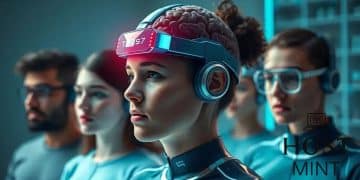Regulation debates heat up over facial recognition use

Regulation debates heat up over facial recognition use as concerns grow regarding privacy, security, and potential misuse, prompting urgent calls for clear guidelines and ethical standards in technology.
Regulation debates heat up over facial recognition use as this technology evolves rapidly. But how does this affect our daily lives and privacy? Let’s explore the implications together.
Understanding facial recognition technology
Understanding facial recognition technology is crucial as it plays a key role in modern security and identification systems. This technology uses algorithms to identify or verify a person’s identity based on their facial features. As it evolves, its applications and implications continue to expand.
How Facial Recognition Works
This technology relies on machine learning and artificial intelligence. A camera captures an image of a face, and the software analyzes it. It picks out important features, such as the distance between the eyes or the shape of the jaw.
After analyzing these features, the system compares them to a database containing millions of facial images. If there’s a match, the software can identify or authenticate the individual in just seconds.
Common Applications
- Security systems use facial recognition for access control.
- Law enforcement utilize it to track down suspects efficiently.
- Social media platforms apply it for tagging friends in photos.
- Smartphones employ this technology for user authentication.
The potential uses for facial recognition are vast, but so are the concerns surrounding privacy and ethics. As we embrace this groundbreaking technology, it’s essential to stay informed and consider both its benefits and pitfalls.
Current regulations and policies

Current regulations and policies surrounding facial recognition are evolving rapidly. Different countries and regions are taking various approaches to address the challenges and opportunities that this technology presents.
In the United States, some cities and states have implemented strict regulations. For instance, San Francisco has banned the use of facial recognition by city agencies. This reflects growing concerns over privacy and surveillance. Meanwhile, some states are exploring the idea of comprehensive laws to govern its use.
European Union Policies
The European Union is at the forefront of establishing regulations that aim to protect citizens. The General Data Protection Regulation (GDPR) includes provisions regarding personal data, which impacts how facial recognition technology can be used.Compliance with these regulations is necessary for companies operating within EU borders.
Key Aspects of Current Regulations
- Transparency in data collection and usage.
- Explicit consent from individuals before their data is used.
- Accountability for companies regarding data breaches.
- Clear penalties for non-compliance with regulations.
These regulations highlight the balance that needs to be achieved between technological advancement and the protection of individual rights. As facial recognition technology becomes more integrated into society, monitoring how these regulations adapt will be essential.
Privacy concerns surrounding facial recognition
Privacy concerns surrounding facial recognition are significant and have attracted much attention. As this technology becomes more common, people are becoming increasingly aware of how their personal data is being used.
One major concern is the potential for constant surveillance. Many individuals worry that facial recognition could lead to a world where their movements are tracked continuously. This raises questions about freedom and personal space.
Key Privacy Issues
Facial recognition technology often operates without explicit consent. Many people do not realize when their faces are being captured and analyzed. This lack of transparency can lead to feelings of vulnerability and distrust in technology.
- Data security is another significant issue. If facial recognition databases are hacked, sensitive personal information could be exposed.
- Misuse of the technology can lead to wrongful profiling and discrimination. This is particularly concerning for marginalized communities.
- Errors in facial recognition can result in false identifications, leading to wrongful accusations and legal troubles.
- The potential for governmental overreach in monitoring citizens raises ethical questions about individual rights.
These privacy issues are prompting calls for stricter regulations and accountability among companies that use this technology. As society adapts to these advancements, it is crucial to address these concerns thoughtfully and proactively.
Innovative uses of facial recognition
Innovative uses of facial recognition are reshaping various sectors. This technology offers creative solutions to challenges faced in security, customer service, and more, highlighting its versatility.
One notable area is in security systems. Businesses and institutions are increasingly adopting facial recognition to enhance safety. This enables quicker access control and effective monitoring in sensitive areas.
Facial Recognition in Customer Experience
Retailers are finding innovative ways to use this technology to improve customer experiences. By analyzing customer data, they can provide personalized recommendations and offers, making shopping more engaging.
- Recognizing loyal customers when they enter the store.
- Customizing advertisements based on the demographic of shoppers.
- Facilitating a smoother checkout process with face-based payments.
In healthcare, facial recognition is also being adopted for security purposes. Hospitals use it to manage access to patient information and secure facilities. Moreover, the technology can track patients in real-time, improving safety and resource management.
Technology in Law Enforcement
Another important use is in law enforcement. Facial recognition helps identify suspects more quickly by comparing images with databases. This can lead to faster investigations and improved public safety.
Many organizations also employ facial recognition for workforce management, ensuring secure access to buildings and tracking employee attendance. This leads to greater efficiency as companies can streamline their processes, saving time and resources.
These innovative uses of facial recognition demonstrate its potential to transform various industries. As technology continues to advance, the possibilities seem endless.
Future of regulation in tech
The future of regulation in tech is a topic of great importance as technology evolves rapidly. Regulatory frameworks need to keep pace with advancements to ensure safety, privacy, and fairness.
As technologies like facial recognition continue to grow, regulators face challenges in crafting rules that protect individuals without stifling innovation. Policymakers must find a balance that fosters technological growth while addressing public concerns.
Emerging Trends in Regulation
One emerging trend is the concept of ethical guidelines for artificial intelligence (AI) and facial recognition. Many industry leaders advocate for clear standards to ensure responsible use of technology.
- Transparency in algorithms and data usage.
- Accountability for developers and companies using such technology.
- Involvement of diverse stakeholders in the regulatory process.
Another trend is the global approach to regulation. Countries around the world are beginning to collaborate, sharing insights and strategies to create a more unified regulatory environment. This can lead to consistent standards that enhance user trust across borders.
Technological Solutions for Regulation
Technological solutions, such as built-in compliance features, are becoming vital for facilitating regulation. Companies are now integrating these features into their applications to ensure they meet regulatory requirements.
Additionally, public awareness and education play essential roles in the future of regulation. As consumers become more knowledgeable about their rights, policymakers are more likely to respond to public demand for better regulation. Engaging in discussions about the implications of new technologies helps create informed regulation.
The future of regulation in tech will likely be shaped by adaptability and collaboration among governments, industries, and the public.
The future of facial recognition and its regulation will depend on a balance between innovation and ethical use. As we navigate this rapidly changing landscape, it is essential to consider privacy, security, and the implications of new technologies.
By encouraging collaboration among stakeholders and keeping the public informed, we can create a regulatory environment that supports technological growth while protecting individual rights. Understanding these dynamics will help society harness the benefits of facial recognition while addressing its challenges responsibly.
FAQ – Questions About Facial Recognition Technology and Regulation
What are the main concerns regarding facial recognition?
Main concerns include privacy issues, potential for misuse, and the risk of false identifications.
How is facial recognition regulated?
Regulations vary by region, with some places implementing strict protocols to protect individual privacy.
What are innovative applications of facial recognition?
Innovative applications include enhancing security systems, improving customer experiences in retail, and assisting in law enforcement.
Why is public awareness important in tech regulation?
Public awareness encourages informed discussions and promotes accountability among companies, leading to better regulation.






